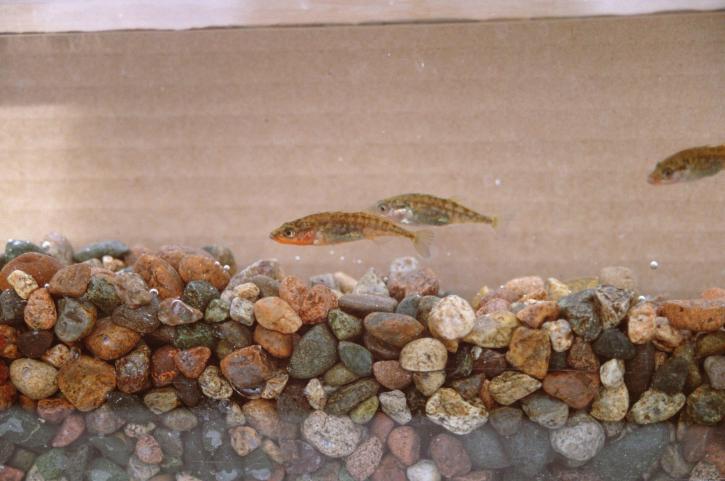Gasterosteus aculeatus williamsoni
 With three spines on its back and an aggressive attitude, this two inch-long fish is a tougher customer than one may think. The unarmored threespine stickleback inhabits a handful of stream systems within Southern California, including Canada Hondo and San Antonio creeks in Santa Barbara County. Individuals of this species can be extremely territorial, especially when spawning, often darting and charging at larger fish or other unarmored threespine sticklebacks to keep their nests and eggs safe. Though they often dwell in shallow, slow-moving water, the three spines on their back make them a less-than-desirable target for birds and other predators. Despite its tenacity however, the unarmored threespine stickleback is vulnerable to many threats that have greatly diminished the numbers and range of historic populations, leading to its classification as a ‘fully protected’ species under California Law in the 1960s.
With three spines on its back and an aggressive attitude, this two inch-long fish is a tougher customer than one may think. The unarmored threespine stickleback inhabits a handful of stream systems within Southern California, including Canada Hondo and San Antonio creeks in Santa Barbara County. Individuals of this species can be extremely territorial, especially when spawning, often darting and charging at larger fish or other unarmored threespine sticklebacks to keep their nests and eggs safe. Though they often dwell in shallow, slow-moving water, the three spines on their back make them a less-than-desirable target for birds and other predators. Despite its tenacity however, the unarmored threespine stickleback is vulnerable to many threats that have greatly diminished the numbers and range of historic populations, leading to its classification as a ‘fully protected’ species under California Law in the 1960s.
Habitat and Life History
While the unarmored threespine stickleback used to inhabit many freshwater systems in southern California, populations are now limited to relatively few stream networks within Santa Barbara, Los Angeles, San Bernardino, and San Diego counties. Historic populations that inhabited the Santa Maria River stream network are all extinct and no populations currently exist within the Los Padres National Forest. Still, there is the potential for unarmored threespine sticklebacks to travel upstream from reaches they currently inhabit to streams within the Los Padres National Forest once again. Unarmored threespine sticklebacks prefer environments with slow-moving water, a moderate density of algae, richly-vegetated banks, and a sandy substrate. It is in such areas where males construct their nests.
Once a male has established its territory, it will dig a pit in the sand and deposit algae and other plants into the pit, pasting them together with a sticky secretion from its kidney. The male will then burrow a tunnel through this conglomeration before seeking out a female. Once the male has found an interested female, she will follow him back to the nest to lay her eggs. After she is finished, the male immediately chases her away before fertilizing the eggs and taking up his post as guard of the nest. Though he is small, the male is aggressive in guarding his eggs, lunging at potential attackers (which include other unarmored threespine sticklebacks) to scare them off. The eggs hatch after 6-8 days and the male hangs around for a few more days until the fry become too unruly to protect. He then wanders off to make another nest and spawn again, or to join a school of unarmored threespine sticklebacks.
While sticklebacks are very territorial around their nests, they often school to increase feeding efficiency when it is not the mating season. Sticklebacks feed mainly on small invertebrates that live among aquatic plants found in streams and rivers. They are visual feeders and require fairly clear water to locate their food.
Threats and Conservation Issues
Many threats exist for unarmored threespine stickleback populations. The disease “Ich” (Ichthyopthrius multifilis) has wiped out large portions of isolated populations in the past, though it currently seems to be relatively under control. Another threat is from vehicle access to streams where unarmored threespine sticklebacks reside. Vehicles stir up dirt and sand which clouds the water and can lead to increased sedimentation, destroying breeding habitat for the fish and making it difficult for the sticklebacks to see their food. Additional threats include water diversion or extraction, and input of toxics to inhabited stream reaches.
Though the unarmored threespine stickleback has been listed as ‘endangered’ since 1970, no critical habitat has been designated as of this time. This is due to the fact that the critical habitat provision of the Endangered Species Act was not added until 1978, years after the unarmored threespine stickleback was listed as endangered. Consequently, courts have ruled that designation of critical habitat for the species is discretionary, not mandatory, creating problems for environmental groups seeking to aid in the recovery of threatened populations of the fish.
Los Padres ForestWatch monitors, and seeks to prevent activities that threaten unarmored threespine stickleback populations in and around the Los Padres National Forest.






